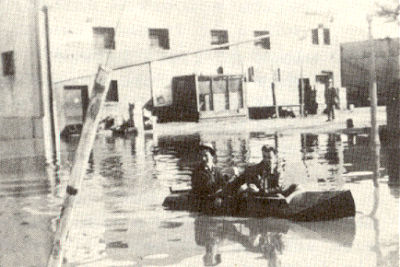The History of Hawthorne by Robert S. Hartman
But if the experts are to be believed, his creative abilities to shape metals into beautiful objects and patterns equaled the craftsmanship of Cellini and the famed silversmith, Paul Revere. He had a smelter on Hawthorne Boulevard near 120th Street and a home on Freeman just south of the railroad. Both were filled with his artistic creations. Some of those remembered were a beautiful girl milking a goat, a half man and half animal; and his "Door of Life", a 700-pound creation that disappeared for years but is presently displayed at the Inglewood Park Cemetery. He had Hawthorne's first swimming pool and instead of filling it with water, he put his treasures there and covered them with several feet of earth to avoid theft. During the First World War, he buried the door for fear the government, searching for scrap copper, would take it from him. The wall around his home was unique; he collected discarded water heaters, set them in cement for columns, installed ironwork between them over which he molded plaster figurines for decoration. Before coming to Hawthorne in 1916, he taught art and metal sculpture at the University of California in Berkeley. He and the famous author, Jack London, lived at the Peano home which was a tourist attraction, with its fluted columns. He died in Hawthorne a few years after the city's incorporation.
During the first two decades after incorporation, Hawthorne suffered some setbacks. In the 1930's approximately 3000 parcels of property were tax delinquent, some available at $1 each. The parcels were sold by the County to the State which, in turn, sold them back the County which transferred the parcels to the welfare board at a very low fee. A great many indigent families rented these lots for $5 monthly. Most of the renters constructed shacks to live in and used the land for growing vegetables and other produce. Forty-five percent of the population of Hawthorne was on relief in 1935-36.
Hawthorne had another problem during this period; gambling and all its side effects secured a strong hold on the community. For a time this lawless element infiltrated many of the public service agencies and was virtually running the city. During this period, the weekly newspaper changed hands and the new publisher started a vigorous campaign to eliminate the evil. With the help of civic leaders, a proposal to eradicate gambling was put on the ballot in 1942. Although the gambling interests contested the proposal with every means possible, the citizens voted them out.
A small "oil boom" along Inglewood Avenue came about during this period and several derricks inspired investors to purchase property. No one struck oil and these properties also became tax delinquent.
 Another type of problem confronted the city for many years - the accumulation of flood waters during each rainfall. The intersection of Hawthorne Boulevard and Broadway was often deluged with a lake of water. It was a common sight to witness boats traversing the area and vehicles stalled in the water and mud. Such conditions caused much property damage and an important loss of revenue to the business firms. The problem was further complicated by the fact that Hawthorne Boulevard was a state highway controlled by the state. The County of Los Angeles was responsible for flood control. After several years of public meetings and protest hearings, the city, aided by the chamber of commerce, succeeded in eliminating the flood conditions, and in 1952 the boulevard underwent major improvements which included paving of the center islands for parking strips.
Another type of problem confronted the city for many years - the accumulation of flood waters during each rainfall. The intersection of Hawthorne Boulevard and Broadway was often deluged with a lake of water. It was a common sight to witness boats traversing the area and vehicles stalled in the water and mud. Such conditions caused much property damage and an important loss of revenue to the business firms. The problem was further complicated by the fact that Hawthorne Boulevard was a state highway controlled by the state. The County of Los Angeles was responsible for flood control. After several years of public meetings and protest hearings, the city, aided by the chamber of commerce, succeeded in eliminating the flood conditions, and in 1952 the boulevard underwent major improvements which included paving of the center islands for parking strips.
Recollections | Reunions | Street Scene | Teachers | Tributes | Vietnam | What's New | Keyword Search